

Life Quality Project. Spirituality. The term "spirituality" lacks a definitive definition, although social scientists have defined spirituality as the search for "the sacred," where "the sacred" is broadly defined as that which is set apart from the ordinary and worthy of veneration.
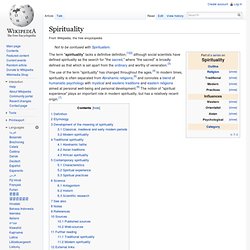
Definition[edit] There is no single, widely-agreed definition of spirituality. Religion. Religious activities around the world Many religions may have organized behaviors, clergy, a definition of what constitutes adherence or membership, holy places, and scriptures.
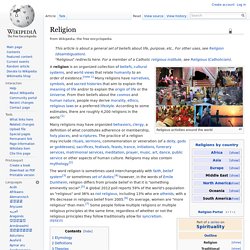
The practice of a religion may include rituals, sermons, commemoration or veneration (of a deity, gods or goddesses), sacrifices, festivals, feasts, trance, initiations, funerary services, matrimonial services, meditation, prayer, music, art, dance, public service or other aspects of human culture. Religions may also contain mythology.[2] Etymology Religion (from O.Fr. religion "religious community," from L. religionem (nom. religio) "respect for what is sacred, reverence for the gods,"[11] "obligation, the bond between man and the gods"[12]) is derived from the Latin religiō, the ultimate origins of which are obscure.
Many languages have words that can be translated as "religion", but they may use them in a very different way, and some have no word for religion at all. Definitions Theories. Islam. Islam (/ˈɪslɑːm/;[note 1] Arabic: الإسلام, al-ʾIslām IPA: [ælʔɪsˈlæːm] ( )[note 2]) is a monotheistic and Abrahamic religion articulated by the Qur'an, an Islamic holy book considered by its adherents to be the verbatim word of God (Allāh), and for the vast majority of adherents, also by the teachings and normative example (called the Sunnah and composed of hadith) of Muhammad (c. 570–8 June 632 CE), considered by most of them to be the last prophet of God.
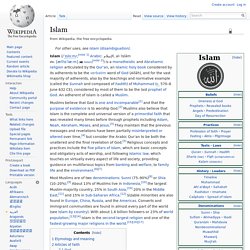
An adherent of Islam is called a Muslim. Most Muslims are of two denominations: Sunni (75–90%)[8] or Shia (10–20%).[9] About 13% of Muslims live in Indonesia,[10] the largest Muslim-majority country, 25% in South Asia,[10] 20% in the Middle East,[11] and 15% in Sub-Saharan Africa.[12] Sizable minorities are also found in Europe, China, Russia, and the Americas. Converts and immigrant communities are found in almost every part of the world (see Islam by country). Etymology and meaning Articles of faith God Angels Revelations Prophets. Judaism. Judaism (from the Latin Iudaismus, derived from the Greek Ἰουδαϊσμός, and ultimately from the Hebrew יהודה, Yehudah, "Judah";[1][2] in Hebrew: יהדות, Yahadut, the distinctive characteristics of the Judean ethnos)[3] is the religion, philosophy and way of life of the Jewish people.[4] Judaism is a monotheistic religion, with the Torah as its foundational text (part of the larger text known as the Tanakh or Hebrew Bible), and supplemental oral tradition represented by later texts such as the Mishnah and the Talmud.
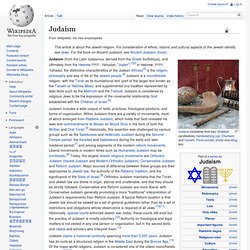
Judaism is considered by religious Jews to be the expression of the covenantal relationship God established with the Children of Israel.[5] Judaism includes a wide corpus of texts, practices, theological positions, and forms of organization. Judaism claims a historical continuity spanning more than 3,000 years. Defining character and principles of faith Defining character.
History of Zionism. Zionism as an organized movement is generally considered to have been fathered by Theodor Herzl in 1897; however the history of Zionism began earlier and related to Judaism and Jewish history.
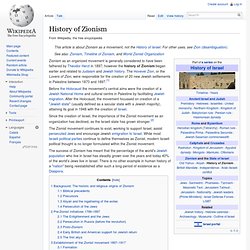
The Hovevei Zion, or the Lovers of Zion, were responsible for the creation of 20 new Jewish settlements in Palestine between 1870 and 1897.[1] Before the Holocaust the movement's central aims were the creation of a Jewish National Home and cultural centre in Palestine by facilitating Jewish migration. After the Holocaust, the movement focussed on creation of a "Jewish state" (usually defined as a secular state with a Jewish majority), attaining its goal in 1948 with the creation of Israel.
Zionism. Theodor Herzl is considered the founder of the Zionist movement.
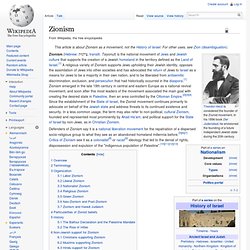
In his 1896 book Der Judenstaat, he envisioned the founding of a future independent Jewish state during the 20th century. Zionism (Hebrew: צִיּוֹנוּת, translit. Tsiyonut) is the national movement of Jews and Jewish culture that supports the creation of a Jewish homeland in the territory defined as the Land of Israel. A religious variety of Zionism supports Jews upholding their Jewish identity, opposes the assimilation of Jews into other societies and has advocated the return of Jews to Israel as a means for Jews to be a majority in their own nation, and to be liberated from antisemitic discrimination, exclusion, and persecution that had historically occurred in the diaspora.
Overview. The Return to Zion. Christianity. Christianity is an Abrahamic religion that began as a Jewish sect in the mid-1st century.[9][10] Originating in the Levant region of the Middle East, it quickly spread to Syria, Mesopotamia, Asia Minor and Egypt. It grew in size and influence over a few centuries, and by the end of the 4th century had become the official state church of the Roman Empire, replacing other forms of religion practiced under Roman rule.[11] During the Middle Ages, most of the remainder of Europe was Christianized, and adherents were gained in the Middle East, North Africa, Ethiopia and parts of India.[12][13] Following the Age of Discovery, Christianity spread to the Americas, Australasia, sub-Saharan Africa, and the rest of the world through missionary work and colonization.[14][15][16] Christianity has played a prominent role in the shaping of Western civilization.[17][18][19][20][21] Beliefs Creeds Its main points include: Ten Commandments These are quotes from Deuteronomy 6:4 and Leviticus 19:18.
Spirituality. Foundation: Spiritual Community, Ecovillage and Education Centre. Prehistoric religion. Prehistoric religion is a general term for the religious beliefs and practices of prehistoric peoples.
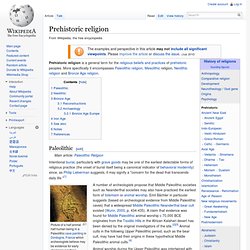
More specifically it encompasses Paleolithic religion, Mesolithic religion, Neolithic religion and Bronze Age religion. Paleolithic[edit] Intentional burial, particularly with grave goods may be one of the earliest detectable forms of religious practice (the onset of burial itself being a canonical indicator of behavioral modernity) since, as Philip Lieberman suggests, it may signify a "concern for the dead that transcends daily life. "[1] Picture of a half animal half human being in a Paleolithic cave painting in Dordogne, France which archeologists believe may be evidence for early shamanic practices.
A number of archeologists propose that Middle Paleolithic societies such as Neanderthal societies may also have practiced the earliest form of totemism or animal worship. Neolithic[edit] Bronze Age[edit] Reconstructions[edit] Archaeology[edit] Bronze Age Europe[edit] Iron Age[edit] See also[edit] Solar deity. Statue of Hathor – Luxor Museum The winged sun was an ancient (3rd millennium BC) symbol of Horus, later identified with Ra A solar deity (also sun god/dess) is a sky deity who represents the Sun, or an aspect of it, usually by its perceived power and strength.
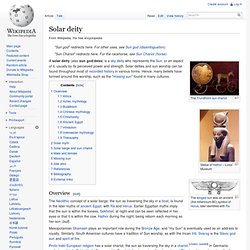
Solar deities and sun worship can be found throughout most of recorded history in various forms. Hence, many beliefs have formed around this worship, such as the "missing sun" found in many cultures. Religions of the Ancient Near East. The religions of the ancient Near East were mostly polytheistic, with some early examples of primitive monolatry (Mardukites), Ashurism and Monism (Atenism).
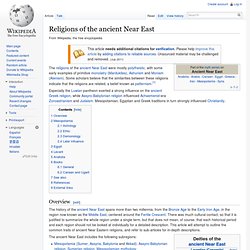
Some scholars believe that the similarities between these religions indicate that the religions are related, a belief known as patternism.[1] Especially the Luwian pantheon exerted a strong influence on the ancient Greek religion, while Assyro-Babylonian religion influenced Achaemenid-era Zoroastrianism and Judaism. Mesopotamian, Egyptian and Greek traditions in turn strongly influenced Christianity. Overview[edit] Mesopotamian mythology. The god Marduk and his dragon Mušḫuššu Mesopotamian religion refers to the religious beliefs and practices followed by the Sumerian and East Semitic Akkadian, Assyrian, Babylonian and later migrant Arameans and Chaldeans, living in Mesopotamia (a region encompassing modern Iraq, Kuwait, southeast Turkey and northeast Syria) that dominated the region for a period of 4200 years from the fourth millennium BCE throughout Mesopotamia to approximately the 10th century CE in Assyria.[1] Mesopotamian polytheism was the only religion in ancient Mesopotamia for thousands of years before entering a period of gradual decline beginning between the 1st and 3rd centuries CE.
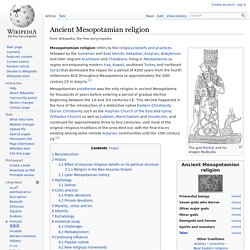
Reconstruction[edit] Sumer. The irrigated farming together with annual replenishment of soil fertility and the surplus of storable food in temple granaries created by this economy allowed the population of this region to rise to levels never before seen, unlike those found in earlier cultures of shifting cultivators. This much greater population density in turn created and required an extensive labour force and division of labour with many specialised arts and crafts.
Sumerians. Sumerian religion. Lunar deity. The Hindu Chandra, riding his celestial chariot. Moon in mythology[edit] Also of significance is that many religions and societies are oriented chronologically by the Moon as opposed to the sun. One common example is Hinduism in which the word Chandra means Moon and has religious significance during many Hindu festivals (e.g.